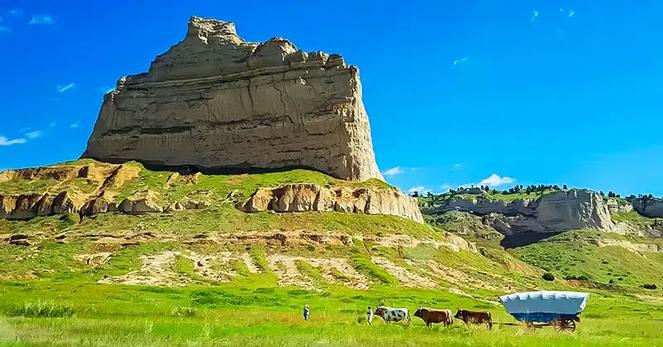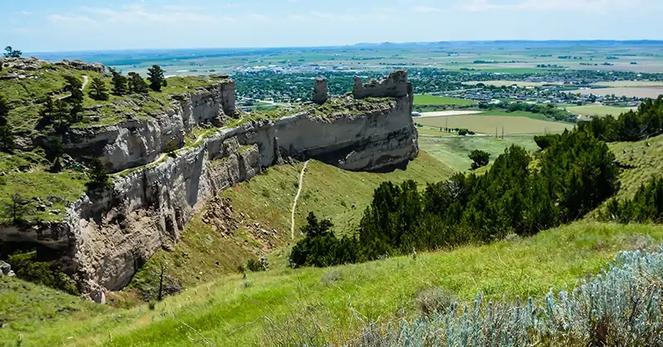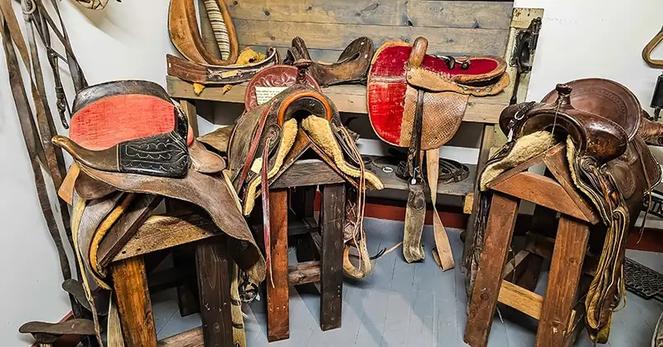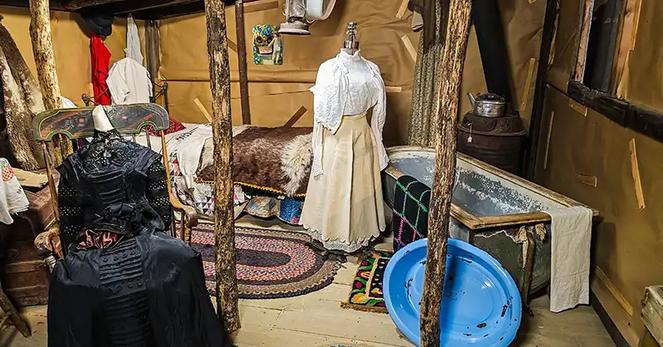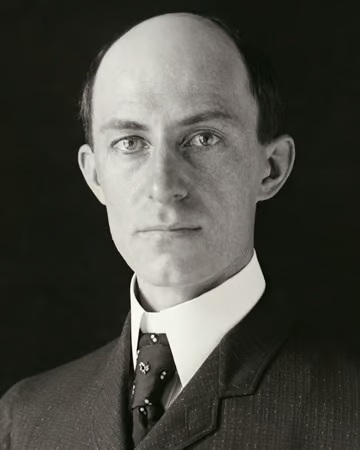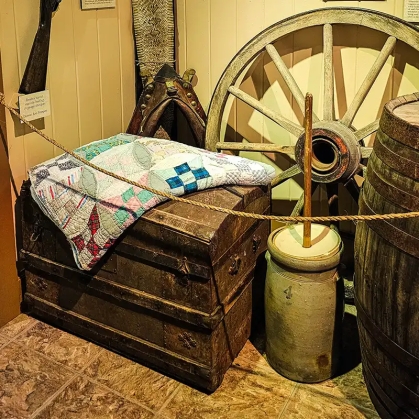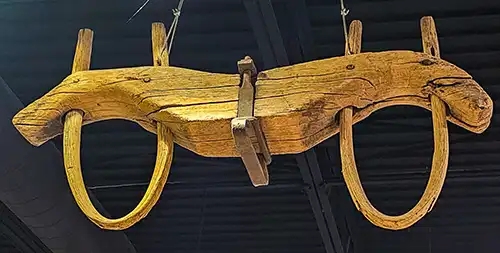See 100 Miles Across Nebraska From Scotts Bluff National Monument
The U.S. Government recognized Scotts Bluff, Nebraska, as an official National Monument in 1919. Located near Gering in Western Nebraska, this landmark helped guide pioneers on the Oregon, California, and Mormon Trails.
Scottsbluff National Monument. Photo by Linda Aksomitis.Linda’s Pick of the Exhibits
The museum at the Scottsbluff National Monument is called the Oregon Trail Museum and Visitor Center. While the museum is small, its exhibits are packed with information.
My favorite?
I have to say I found the stories of the first European fur traders to visit the area the most interesting. Of course, the fact that reproduced pages from their journal indicate the first group visited on Christmas Day, 1812, makes the visit a little more memorable.
Fast Fact: Seven fur traders left from Astor's Trading Post on the Columbia River in Oregon. They headed to St. Louis following a new route that stopped at the Scottsbluff landmark. That route eventually became the Oregon Trail. Unfortunately for the men, the War of 1812 obscured their discovery.
Later, in 1825, Hiram Scott, a fur trader employed by General William H. Ashley’s Rocky Mountain Fur Company came through with his group. While stories vary, the museum narrates the story beginning with a group of fur traders being attacked and one injured.
Scott was the injured man. Two other men were detailed by Sublette, an agent of the Rocky Mountain Fur Company, to take Scott downstream to the great bluffs where they’d be met. However, one disaster followed another, and the boat capsized en route.
The tragedy of Hiram Scott display. Photo by Linda Aksomitis.The men had no food or dry gunpowder to defend themselves and panicked. They deserted Scott and caught up to the main party reporting that Scott had died.
But he hadn’t — at least not yet — instead he dragged himself to the bluffs. Of course, he had no food or water and did soon die.
The following spring, Sublette’s hunters found his skeleton. By tacit agreement, the great bluffs became a monument to Scott’s memory.
What’s at Scotts Bluff National Monument
Scotts Bluff National Monument is a rock of sorts, a formation of sandstone, siltstone, volcanic ash and limestone topped off with a caprock, or “lid,” of hard limestone that keeps it from eroding. It has 740 feet of continuous geological strata visible along the north face of Scotts Bluff.
What’s a bluff?For me, the term “bluff” is where speaking “American” and “Canadian” starts to become a problem. In Saskatchewan, at least, a bluff is a small outcropping of trees. According to Wikipedia it seems this meaning is restricted to the Canadian prairies. And when you find a bluff you won’t find any hills, rocky or otherwise.
However, according to National Geographic, a bluff is a type of broad, rounded cliff typically near water. Since it lists bluff formations everywhere from Mars to South Africa to the Cayman Islands, I have to surmise that our “local” version of the word is a little flawed.
Such is language.
On a clear day, you see for forever…or almost forever, at the top of Scotts Bluff. In fact, Laramie Peak,100 miles to the West, appears on the horizon.
Those early settlers walking the Oregon Trail must have been stunned to find it! And according to journals and letters many left behind, just the shade from the Ponderosa Pines at the higher elevations was a relief. Indeed, back when they were crossing Mitchell Pass, no trees grew along the North Platte River at all.
View from top of Scotts Bluff taken on a hike up the path. Photo by Linda Aksomitis.But that’s not what you’ll see today. In fact, the Park Service planted 23,000 shrubs and trees in the 1930s. Now, even if you’re not looking for a shady tree, I can guarantee the sights merit the time — and energy — however you decide to reach the top.
In addition to Mitchell Pass and Wyoming to the west, the Wildcat Hills appear to the south (bordering the side of the North Platte Valley) and Chimney Rock to the east.
Scotts Bluff Hiking Trails
A variety of hiking trails let you explore various parts of the
Scotts Bluff changing landscape. While short trails take you to the north and south rims of the bluff, the south trail gives you a view of Mitchell’s Pass.
Fast Fact: The oldest exposed rocks at Scotts Bluff are 33,000 years old. Each different colored layer of Scotts Bluff tells a new story of local conditions over the centuries. In fact, its exposed north face provides the longest geological history in Nebraska.
And of course, a longer trail goes all the way from the Visitor Center at the bottom, to the top of the bluff. It covers about a mile-and-a-half.
When that hot Nebraska sun is overhead though, you may want to go down the bluff rather than up! That still takes about half-an-hour with the terrain changes.
Viewing area at top of Scotts Bluff. Photo by Linda Aksomitis.For those not up to the hike, it’s easy to get to the top by Summit Road. My favorite part of the 1.6 mile drive? The three tunnels carved into the bluff. If you visit with an RV, or have a trailer in tow, the Visitor Center has a shuttle. Or, if your whole group wants to hike down — but not up — you can take the shuttle.
Oregon Trail Museum and Visitor Center
The museum complex covers approximately 6,677 square feet. While the original construction was in 1935, there have been several expansions including:
- Paleontology wing: home to fossils from the Brule Formation. This formation dates back 33 to 22 million years ago. It includes oredonts, stylemys (a dry land tortoise), and other vertebrate fossils like early rhinoceroses and deer-like animals.
- William Henry Jackson Wing: rotating pieces of William Henry Jackson’s watercolors, sketches and photos. Jackson was an artist and adventurer, who had a role in the 1871 U.S. Geological Survey. He aided in establishing Yellowstone as the world’s first national park in 1972.
The museum also offers seasonal living history programs. Costumed interpreters are dressed as 1850s pioneers following the Oregon Trail with their covered wagon. They demonstrate pioneer life activities such as cook over open fires and repairing wagon wheels.
Linda’s Road Trip Tips
First, let me say my week in this part of Nebraska was one of my best trips ever! There’s just so much history representing many eras, from fossils up to 18,000 years old to the Pony Express.
Check out the preserved wagon tracks at Windlass Hill. They were left by the half million or so people who traveled the Oregon Trail between 1843 and 1869, one step at a time beside their oxen. How far? Roughly 2000 miles!
When it comes to museums, be sure to visit the Legacy of the Plains Museum in Gering and Museum of the Fur Trade in Chadron. Andif you’d like something a little different, I really enjoyed the Petrified Wood Gallery in Ogallala.
While the week was full of great meals, some really stood out.
- The Tangled Tumbleweed Tapas inspired eater in Scottsbluff
- Emporium Coffeehouse in Scottsbluff
And if you’d like a unique place to stay for the night, the off-the-beaten-path High Plains Homestead is awesome. There are rustic rooms and glamping options in the great outdoors, so you’ll be able to see the night sky clearly.
Who Should Visit Scotts Bluff National Monument?
If you’re on a road trip through western Nebraska, Scotts Bluff National Monument is a must-do stop. The area is rich in history, whether you’re looking for geologic history or stories of emigrants on the Oregon Trail.
Pin me!The hiking trail up the monument provides a great opportunity to stretch and enjoy the view. And, if you’re not able to walk that far, you can use the shuttle to get to the top.
Park rangers provide various summer programs from Memorial Day to Labor Day. I especially enjoyed the emigrant experience with costumed rangers and learning about cooking on the trail.
The amount of time required will depend on how much focus your stop has on nature and hiking. While the Oregon Trail Museum and Visitor Center is small, there’s a lot of information included.
And of course, the William Jackson Henry Art Gallery can also take quite a bit of time. I was here for half a day and enjoyed every minute.
Scotts Bluff National Monument has various accessibility features. Parking, restrooms, ranger programs and some trails are accessible. The Saddle Rock Trail is partially accessible with the first 700 yards being wheelchair and stroller-friendly.
How Do You Visit Scotts Bluff National Monument
Scotts Bluff National Monument is in rural Western Nebraska. It’s located three miles west of the town of Gering.
Parking: The site has lots of free parking.
Street Address: 190276 Old Oregon Trail, Gering, Nebraska. The National Park Service provides full directions on various forms of transportation.
Pin me!Visit the Scotts Bluff National Monument website from the National Park Service for more information.
Keep up-to-date with what’s happening with the Scotts Bluff National Monument Facebook page.
Take a virtual tour of The Oregon Trail Through the Historic Scotts Bluff in Nebraska on YouTube.
Plan your visit with Google maps.
Reference(s)
Oregon Trail Museum Association. (1962). History of Scotts Bluff National Monument. https://www.nps.gov/parkhistory/online_books/scbl/history/foreword.htm
Acknowledgments
These stops were all part of a Fam tour hosted by the Gering Convention and Visitors Bureau, Scotts Bluff Area Visitors Bureau, and Nebraska Tourism Commission.
More Places to See in Nebraska
Check out all of guide2museum.com’s reviews of museums in Nebraska.
Read More Reviews of Historic Sites
-
See 100 Miles Across Nebraska From Scotts Bluff National Monument
-
Rip Van Winkle Gardens & Historic Mansion: Jefferson Island, Louisiana
-
Robinson Roadhouse & Robinson Flag Station: Yukon Ghost Town
-
USS Lexington Museum: WWII Aircraft Carrier in Corpus Christi, Texas
-
Watson Lake Sign Post Forest Historic Site: Watson Lake, Yukon
-
Claybank Brick Plant National Historic Site: Claybank, Saskatchewan
-
The Sheriff’s House Museum & Historic Site: A Hidden Gem in Devils Lake, North Dakota
-
Soo Line Historical Museum & Historic Site: Weyburn, Saskatchewan
-
Texas Seaport Museum: Gulf Coast History in Galveston, Texas
-
Toronto’s First Post Office Museum & National Historic Site: Ontario
-
The Bastion: Designated Historic Place, Nanaimo, British Columbia
-
Hearst Castle: National Historic Landmark in San Simeon, California
-
Inglis Grain Elevators National Historic Site: Agricultural History in Inglis, Manitoba
-
Evergreen Plantation: National Landmark Site in Edgard, Louisiana
-
Cannington Manor Provincial Historic Park: Rich Lifestyles in 1880s Saskatchewan
-
Mystic Seaport Museum: Historic Seafaring Village in Mystic, Connecticut
-
Manhattan Project National Historical Park: WWII History in Hanford, Washington
-
Bagg Bonanza Farm: Historic Landmark in Mooreton, North Dakota
#art #history #lifestyles #museums #Nebraska #pioneers #travel #US_
